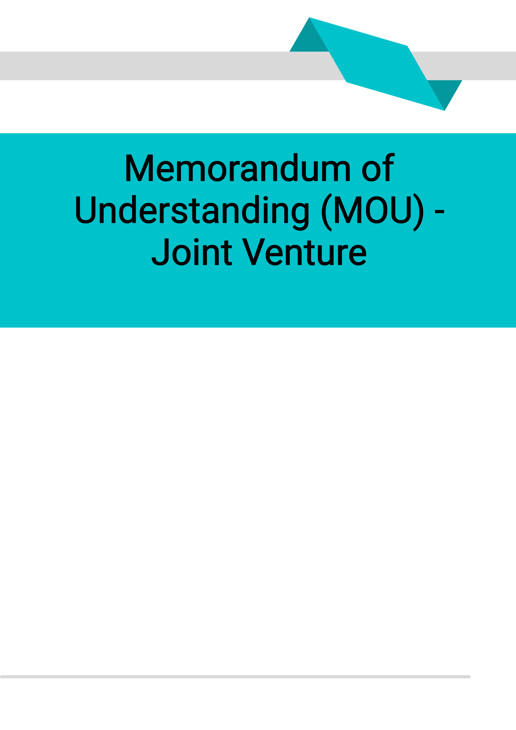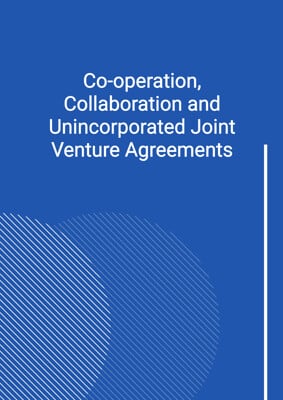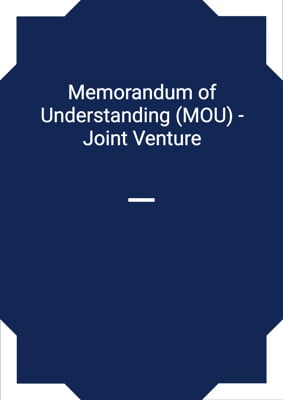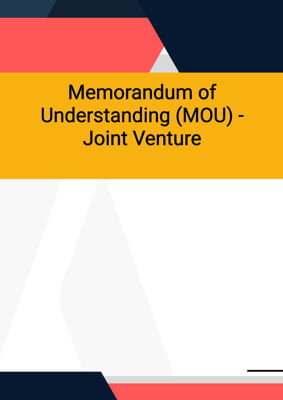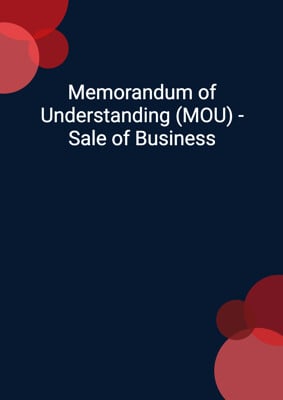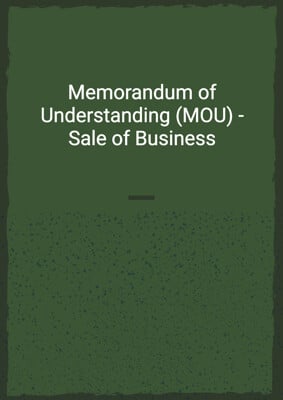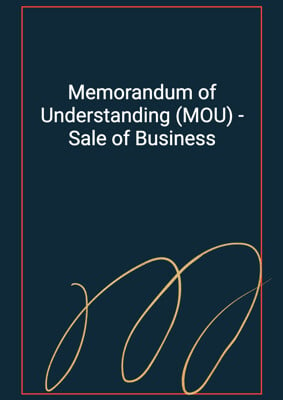How to Tailor the Document for Your Need?
01
Create Document
Fill in the details of the parties. You can click the "Fill with Member’s Information" button to complete it with information saved to your account.
02
Fill Information
Please fill in any additional information by following the step-by-step guide on the left hand side of the preview document and click the "Next" button.
03
Get Document
When you are done, click the "Get Document" button and you can download the document in Word or PDF format.
04
Review Document
Please get all parties to review the document carefully and make any final modifications to ensure that the details are correct before signing the document.
Document Preview
Document Description
This Memorandum of Understanding (MOU) - Joint Venture document is a legally non-binding agreement that outlines the principles and proposed terms of a joint venture between two parties. The document begins by highlighting the importance of the joint venture and the mutual benefits it can bring to both parties. It emphasizes that the detailed terms of the joint venture will be agreed upon in good faith based on the principles set out in the MOU.
The document is divided into several sections, each providing a detailed introduction and description of the key aspects of the joint venture. The first section focuses on the establishment of a joint venture company, explaining that the parties intend to create a new jointly-owned company for the purpose of the joint venture. It also mentions the preferred name of the joint venture and the possibility of alternative structures if tax and cost efficiency require it.
The next section discusses the activities of the joint venture, specifying that the business will be focused on a particular field and may include other technologies and products as agreed upon by the parties. It also mentions the development and approval of an initial business plan, which will be reviewed and updated by the joint venture company's board.
The document then addresses the contribution of each party to the joint venture, including the transfer of existing interests and the continuation of business operations until the joint venture is completed. It also mentions the potential sharing of technology and the licensing of trademarks and names to the joint venture.
Valuation is another important aspect covered in the document. It states that the parties will negotiate and agree on an appropriate valuation process and methodology, potentially involving the appointment of an independent valuer. The parties will provide all necessary information for the valuation process and will bridge any material differences in valuations to maintain the proportionate equity relationship.
Capital and funding are discussed in the next section, highlighting the parties' intention for the joint venture to be self-financing and obtain additional funds from third parties. Each party acknowledges its intention to support the joint venture according to the current business plan and provide necessary guarantees and undertakings.
The document also addresses the composition and responsibilities of the joint venture's board and management. It states that the board will be responsible for overall management and supervision, with each party appointing an equal number of directors and having equal voting rights. The initial appointments to the board and senior management positions are also mentioned.
A shareholders agreement is proposed to govern certain key decisions affecting the joint venture, including changes in the scope or nature of the business, appointment/removal of the chief executive, capital expenditure, borrowings, annual budget approval, material dealings between the joint venture and the parties' groups, and appointment/removal of auditors. The shareholders agreement will also cover dividend policy, auditors, financial year, management accounts, pre-emption rights, non-competition undertakings, and deadlock and dispute resolution.
The document further discusses the need for third-party approvals, such as consents from other partners and relevant regulatory authorities, as well as tax clearances. It emphasizes the parties' commitment to obtaining these approvals as soon as possible and cooperating with each other.
Confidentiality and announcements are addressed in a separate section, stating that each party must keep confidential any information obtained during the negotiation, implementation, or operation of the joint venture, except in certain specified circumstances. It also requires prior written approval for any public announcements or press releases related to the joint venture.
Dispute resolution is briefly mentioned, stating that any legal proceedings concerning or arising out of the agreement will be subject to a jurisdiction clause. The document also includes provisions for notices and service, specifying the methods and timelines for delivering notices between the parties.
Finally, the document includes a clause stating that it does not create any legal obligations, except for certain specified clauses, and that its purpose is to set out the principles for negotiating legally definitive agreements. It is signed by the duly authorized representatives of the parties.
How to use this document?
1. Establish a joint venture company:
- Create a new jointly-owned company for the purpose of the joint venture.
- Consider alternative structures if tax and cost efficiency require it.
2. Define the activities of the joint venture:
- Focus the business on a specific field and agree on the inclusion of other technologies and products.
- Develop and approve an initial business plan.
3. Contribute to the joint venture:
- Transfer existing interests to the joint venture.
- Continue business operations until the joint venture is completed.
- Discuss the sharing of technology and licensing of trademarks and names.
4. Determine the valuation:
- Negotiate and agree on a valuation process and methodology.
- Consider appointing an independent valuer.
- Provide all necessary information for the valuation process.
- Bridge any material differences in valuations to maintain the proportionate equity relationship.
5. Secure capital and funding:
- Aim for the joint venture to be self-financing.
- Obtain additional funds from third parties.
- Support the joint venture according to the current business plan.
- Provide necessary guarantees and undertakings.
6. Establish the board and management:
- Appoint an equal number of directors from each party.
- Give equal voting rights to each party.
- Assign a chairman and deputy chairman.
- Appoint senior management positions.
7. Draft a shareholders agreement:
- Reserve certain key decisions for mutual agreement.
- Address dividend policy, auditors, financial year, management accounts, pre-emption rights, non-competition undertakings, and dispute resolution.
8. Obtain third-party approvals:
- Identify and obtain necessary consents or approvals.
- Seek consents of other partners and regulatory authorities.
- Obtain tax clearances if required.
9. Maintain confidentiality and control announcements:
- Keep information confidential unless required by law or for professional advice.
- Obtain written approval for public announcements or press releases.
10. Resolve disputes:
- Follow the jurisdiction clause for legal proceedings.
11. Serve notices and communicate:
- Provide written notices via email, hand delivery, or recorded delivery.
- Update contact information promptly.
12. Understand the non-binding nature of the MOU:
- Recognize that the MOU does not create legal obligations.
- Use it as a basis for negotiating legally definitive agreements.
- Seek approval from the boards of directors of the parties.
Note: This guidance is a summary and does not cover all details and considerations. Refer to the full document for complete information.
Not the right document?
Don’t worry, we have thousands of documents for you to choose from:
